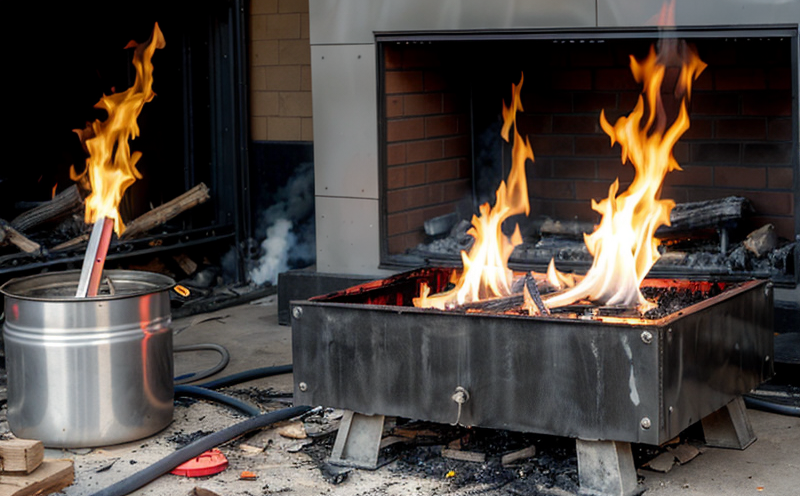Fire & Flammability Testing
In today's rapidly evolving electronics industry, ensuring that products are safe and reliable is paramount. Fire & flammability testing plays a crucial role in safeguarding the integrity of electronic devices across various sectors including consumer electronics, automotive, aerospace, and medical equipment. This form of testing assesses how materials or components behave when exposed to heat, flame, or other ignition sources.
The primary objective of fire & flammability tests is to evaluate a product's resistance to catching fire under specified conditions, ensuring compliance with international safety standards such as UL, IEC, and EN. These tests help manufacturers identify potential risks early in the development process, allowing for necessary modifications before products reach the market.
For quality managers and compliance officers, understanding these tests is essential. They provide critical insights into product design flaws that could lead to fires or other hazards. R&D engineers benefit from detailed test results as they contribute to the ongoing improvement of new designs. Procurement teams also rely on fire & flammability testing data when selecting suppliers.
The process typically involves exposing samples to controlled environments designed to mimic real-world scenarios where materials might encounter flames, such as overheating circuits or accidental ignition sources. Compliance with stringent standards ensures that products meet the highest safety benchmarks and are suitable for use in demanding applications.
When interpreting test results, it's important to consider both quantitative measures like flame propagation rates and qualitative assessments of smoke generation and toxicity. These factors collectively influence decisions regarding design adjustments and material selection. By adhering strictly to prescribed methods outlined by relevant international standards, labs can ensure consistent and accurate outcomes.
In summary, fire & flammability testing is an indispensable tool in preventing fires caused by electronic components or devices. It offers valuable information about the inherent combustibility of materials used in manufacturing processes. Proper implementation helps protect end-users from potential dangers while fostering innovation within the industry.
Why It Matters
The importance of fire & flammability testing cannot be overstated, especially given the increasing complexity and integration of electronics into everyday life. Every year, fires caused by faulty or poorly designed electronic products result in significant property damage, injuries, and even loss of life. By conducting thorough flammability tests during development stages, manufacturers can mitigate these risks significantly.
- Reduces the likelihood of product recalls due to safety concerns
- Promotes safer use of electronics across diverse industries
- Avoids costly legal battles and negative publicity associated with hazardous products
From a regulatory perspective, compliance with fire & flammability testing requirements ensures that companies stay ahead of evolving standards. This proactive approach not only enhances public trust but also fosters competitive advantage by demonstrating commitment to safety.
Incorporating this testing into your quality assurance process is essential for maintaining high standards and ensuring product reliability. It helps build consumer confidence, which translates directly into brand loyalty and market success.
Why Choose This Test
- Meets stringent international safety regulations (UL, IEC, EN)
- Provides critical data for improving product designs
- Reduces the risk of product failures leading to fires or other hazards
- Ensures compliance with industry best practices and standards
The choice of fire & flammability testing is driven by its ability to provide actionable insights into material performance under extreme conditions. This information allows manufacturers to make informed decisions regarding component selection, manufacturing processes, and overall product safety.
By investing in comprehensive fire & flammability tests early on, companies can avoid costly rework late in the design cycle or after products have entered the marketplace. Additionally, these tests enable continuous improvement through iterative refinement of materials and structures based on real-world performance data.
In conclusion, choosing this test demonstrates a commitment to excellence and safety. It positions your organization as a leader in innovation and reliability within the electronics industry.
Customer Impact and Satisfaction
The results of fire & flammability tests have far-reaching implications for customers' experiences with electronic products. When manufacturers invest in robust testing protocols, they ensure that their offerings are not only functional but also safe to use. This commitment translates into increased customer satisfaction and loyalty.
- Enhances user confidence in product safety
- Reduces the chance of accidents or injuries related to electrical fires
- Supports peace of mind for consumers purchasing high-risk products like medical devices or automotive electronics
A satisfied customer base translates into higher sales volumes and stronger brand reputation. Companies that prioritize fire & flammability testing are better equipped to meet evolving market demands, thereby gaining a competitive edge.
Furthermore, adhering to rigorous testing procedures helps establish trust with regulatory bodies and industry peers. This transparency fosters long-term relationships built on mutual respect and shared goals of excellence in safety practices.





